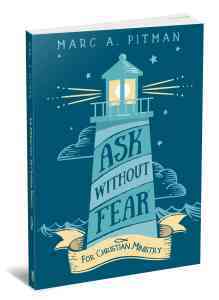Marc A. Pitman's Blog, page 24
May 25, 2017
The conundrum of corporate gifts
Last week, I was able to listen to a terrific discussion from business leaders about how their organizations make corporate gifts to charities. It's always good to hear the thought process of donors. But it sometimes raises more questions than it settles.
Seeking corporate gifts? Don't be "that" guyAt one point in the conversation, one of the panel shared his pet peeve: nonprofits who don't do any research before asking.
The entire panel nodded in agreement.
Each of them had met with nonprofits seeking funding who knew nothing about their business. At all. The message the company gets is "You're not worth anything to us. Just give us money."
That attitude reeks of entitlement. And is quite offensive.
Business leaders are not evilBusiness leaders have even told me that nonprofit leaders have "asked" them for gifts by treating them as less than human. They, the business leaders, were "just" out for profit. They were told they needed to give the nonprofit to prove they had a conscience.
Why would anyone want to give to people that abuse them like those nonprofit leaders abused the business owners? Even if they don't ever make a philanthropic gift, business leaders are making tremendous contributions to our communities. We likely wouldn't have a community if they weren't employing our neighbors.
Do the researchSo a key principle here is: do the research. All of the business leaders agreed that a simple review of their website before getting into the meeting would have strengthened the nonprofits' case.
When deciding how to ask for money, finding out about a prospect - corporate or individual - is just common courtesy.
As you skim through their website, see if you can identify their values. Are they proud to have a strong local economy? Do they seem to love creativity and the arts? And try to find philanthropy priorities too. Do they appear to give only to children? Are they looking for volunteer opportunities for their employees? Do they only seem interested in the city where their headquarters is located?
Which creates the conundrum of corporate giftsWhich leads to the conundrum. Whenever I've listened to corporate donors, they seem to always say, "We don't want to just cut a check." They often want to find causes they can get involved with. Organizations their staff can volunteer with. Groups they can collaborate with.
But every time I've listened to corporate donors, the nonprofit leaders in the room get agitated. Most of them are already working very hard on their mission. They don't really want to take all this time with corporations and employee committees and finding volunteer opportunities. They really just want the check.
And these aren't nonprofits that are trying to be rude or brash. These are nonprofits who will use the donation well and responsibly report back to the business and thank them. They simply want people and organization's who'll donate to them with the fewest strings attached.
Conflicting agendasSo you have a situation where the donor's agenda conflicts with the nonprofit's. If these were individuals, nonprofits would probably agree to politely part ways. It is nice if the prospect is generous, but if that generosity doesn't seem to be in the direction of the nonprofit's strategic plan, you'll end up frustrating each other.
But these aren't individuals. These are businesses. Most nonprofit board members assume businesses are the biggest source of donations (they're not - not by a long shot). And many nonprofit staff secretly feel at least a little empathy to the nonprofit leaders that abused the business owners mentioned above. They feel businesses "owe" them money.
No one owes us a charitable donation. We need to earn it every time. (Click here to tweet that.)
Are corporate gifts worth it?Corporate gifts can be a lot of work. Nonprofit leaders need to do is determine what kinds of philanthropic gifts they want to focus on. If you determine you want a more transactional checkbook philanthropy, corporations are probably not the place to look.
But corporations can be great partners. If your nonprofit is open to volunteer teams, businesses may be able to send those teams. And they may be able to grow into a great collaborative partner.
For example, if your nonprofit is open to gifts of expertise rather than cash, your entire approach may be transformed. The head of corporate social responsibility at a multi-national company once told me of such a transformation. A local soup kitchen had asked the company to fund a specific number of meals. Instead, the company offered a team of its Six Sigma Black Belts. That team observed the soup kitchen's process for acquiring, storing, and serving food. In less than a month, they were able to offer suggestions that drastically improved efficiency, reduced food waste, and saved the soup kitchen thousands of dollars a year. The soup kitchen was even able to serve more people thanks to the improvements suggested by this corporate team.
The savings the soup kitchens achieved will be realized year after year. Because the nonprofit went into the solicitation open to exploring a gift, their community and their nonprofit are both stronger for this business' donation of expertise.
Know your goals. And learn their goals.The bottom line? Corporate gifts can be transformational, but they won't look like gifts from individuals. Corporate donors often have complex objectives they are trying to meet. If you're going to seek corporate gifts, have a clear sense of the goals in your nonprofit's strategic plan. And be ready to listen the business' goals. Where they intersect could be magic.
The post The conundrum of corporate gifts appeared first on FundraisingCoach.com.






May 12, 2017
Even in email fundraising location matters
Effective email fundraising can seem like a mystery. As a nonprofit, you take a lot of time to craft your email. You balance images with words. And you often build up to the ask.
Unfortunately, donors aren't reading your emails like they read a book! They're skimming. So you need to make the point of the email obvious.
A case study of buttons in fundraising emailOne such example is when it comes to giving buttons in nonprofit emails. Last week, our client Love146 was preparing to send out an email appeal.
The top of the email was gorgeous The email is beautiful. The story below it is powerful and written with the donor in mind (rather than being about Love146).
The email is beautiful. The story below it is powerful and written with the donor in mind (rather than being about Love146).
 And the giving buttons illustrate the power of the doubling.
And the giving buttons illustrate the power of the doubling.
 My suggestions
My suggestions
When they asked for my response, I replied:
What they did in the fundraising email they sentPretty. And the doubling buttons are clearer to me.
I like the "you" language.
I guess I'm wondering what could go at that top for all the people who might not scroll down. Maybe a link "Would you help another person like Brianna? Have your gift doubled by clicking here" < -- that can go either to an anchor link in the email attached to the giving buttons, or to the landing page
When I received the actual email, I knew they'd made a change. Look at how clear the donation ask is:

I loved that "DOUBLE YOUR GIFT TODAY - GIVE HERE" jumped out at me. But when I opened the email, it looked the same. I didn't even notice the major change they'd made. Can you see the change?

I totally missed the button on top!
Did the button placement matter?I congratulated the team on getting the "DOUBLE YOUR GIFT" wording to show in the preview. Later, Love146's Creative Director Marilyn Murray told me the results. She wrote:
I was apprehensive at first just putting a give button up above the rest of the content, but figured, "I'll make it really simple and blend in, and hey, MailChimp tells me if things work. So we'll see what the numbers say."
Got some numbers - you can see the attached screenshots for percentages of clicks. Suffice to say, that button you suggested adding was clicked twice as much as any other button in the email!
It blended in so well, I completely missed it. But Love146 readers didn't. Look at these results.


Even with its unobtrusive design, the top button receive more than 25% of the clicks. The bottom three were, from left to right: 13.4%, 10.4%, and 1.5%.
Test. Even if you're also a reluctant donation button designer, test. If it works, keep it.
And in this case, the results are in. If your email is a fundraising email, make sure to have a give button right up where the reader will see it!
It could make all the difference.
Special thanks to Love146 Director of Development Matthew Miller for letting me weigh in on the email. And Love146 Creative Director Marilyn Murray for sharing the wonderful results.
To see the entire email, go to: http://us5.campaign-archive1.com/?u=7a6b54e2653155839888b560b&id=f5bf4ff93e&e=89dd29ba41
The post Even in email fundraising location matters appeared first on FundraisingCoach.com.






April 27, 2017
An accidental fundraiser and data geek
 I've been honored to work with Erin Troia over the years. I haven't met anyone with her ability to make data understandable for fundraisers and nonprofit leaders. I'm thrilled she'll be joining us in The Nonprofit Academy for the webinar Data. Curiosity. Creativity. Building the Bridge.
I've been honored to work with Erin Troia over the years. I haven't met anyone with her ability to make data understandable for fundraisers and nonprofit leaders. I'm thrilled she'll be joining us in The Nonprofit Academy for the webinar Data. Curiosity. Creativity. Building the Bridge.
Since finding a person who understands data and communicates well with people is rare, I invited her in for an interview.
An interview with Erin TroiaMarc: Erin, how did you get into your expertise with fundraising data?
Erin: Just as I am an accidental fundraiser, I am an accidental data geek. My fundraising career started at the College of William and Mary with a serendipitous assistantship in the Annual Fund. I was only working there, managing the Class Agent program, to pay my tuition while I pursued a degree to work in my first love - student affairs. Half way through my Masters program, I realized that I liked being a student and not working with students. With one year to go, I threw myself full tilt into fundraising going on to work at the College for a year after graduating followed by stints in the Annual Fund programs at Georgetown and American University’s law schools.
M: What a great realization! So fundraising seemed a clear choice?
E: Yes. And my direction to success in fundraising seemed clear - to become a star I had to be able to close big gifts. And to do that, I took a position as a Major Gifts Officer in the Madeira School’s $60 million Centennial Campaign. After working my portfolio for a year, the department head took me aside and shared that the Annual Fund was in trouble and she needed me to take over that area instead of focusing solely on major gifts. The Director of Annual Giving position also oversaw advancement services and campaign communications. I bought a book for the latter and sent myself to training to learn Raisers Edge.
M: Wow! Learning Raisers Edge from a book?!
E: Miraculously, I loved it! I was shocked. My previous database experience had been to look up names, record contact reports and submit list requests from complex IT departments to support my segmentation efforts. NOW I was able to manage the pipeline for the campaign, run my OWN annual giving reports, and segment in ways I’d never thought possible. The Madeira Fund went from $1.5 million to $1.8 million in one year and I was hooked.
M: What a great story. And what an introduction to using data for fundraising!
E: Fast forward several years and I have become enamored with data and what it can do to help organizations succeed. The art and style are critical elements, but I have found that data helps drive decisions, provide clarity, and removes the “gut” instincts so many of us find to be a blessing and a curse.
Can you see why I enjoy working with Erin so much? I invite you to join us for her training: Data. Curiosity. Creativity. Building the Bridge. She's basing it off of Dr. Seuss' "Green Eggs & Ham"!
You can learn more at: https://thenonprofitacademy.com/trainings/data-successful-fundraising/
The post An accidental fundraiser and data geek appeared first on FundraisingCoach.com.
April 17, 2017
Is cleverness killing your fundraising?
I sent this reminder to my Fundraising Kick subscribers earlier this month. The response was so good, I wanted to share it with you too.
Heed the warning!

Good morning, Kickers!
I need to apologize. I set out to write this email two days ago.
But the message was so basic, I decided to wait. I wanted to come up with something clever. Something innovative. Something that would make you think, “Gosh, Marc is really smart.”
Fortunately for all of us, that flash of “brilliance” never came.
Why is that fortunate? Such thinking could be the biggest killer of solid fundraising.
We’re going along, doing the slow-seeming, non-flashy tasks of working lists, building relationships, and making asks.
We get bored. We want to impress our board or boss.
So we try to shake things up. Maybe we devote all our attention to Facebook. Or try a crowdfunding campaign. We neglect what’s working in favor of looking for the “new” or what will bring in “new” and “young” donors.
This shift in focus causes us to miss our fundraising goals. And jeopardizes our entire nonprofit’s financial stability.
All because we stopped doing the work of fundraising in favor of something clever and innovative.
Good things we dodged that bullet this month!
Your Mission This WeekIt’s the beginning of April, so run those lists!
People that gave in April last fiscal yearPeople that gave in April two fiscal years agoPeople who gave all of last fiscal year but haven’t yet this year (LYBUNTS)People who gave previous fiscal years but not yet this year (SYBUNTS)Review those lists for people that you’ve stopped following up on. Plan follow up activities – engaging, asking, or loving – and put those activities on your calendar to remind yourself.
And be sure to make those 5 – 10 calls!
You’ve been Kicked,
Marc
If you'd like to get coaching emails like this every week, be sure to subscribe to Fundraising Kick at https://fundraisingcoach.com/fundraisingkick/The post Is cleverness killing your fundraising? appeared first on FundraisingCoach.com.
March 31, 2017
Fundraising and Program Sustainability: The Forgotten Link
 I once heard a fundraiser say this and it shocked me.
I once heard a fundraiser say this and it shocked me.
“Program sustainability has nothing to do with me, does it?”
You see, several years ago, when I decided I was personally ready to make a bequest, I thought long and hard about which organization would receive it. I wanted to choose an organization that I knew was going to be around when the time came years later. I ultimately chose Amnesty International, not because I was already a member, but because they had been around for fifty years. And I felt fairly certain they would be around for another fifty more to use my gift.
There is an undeniable link between fundraising and program sustainability; one that is often forgotten.
What is Program Sustainability?There are several different types of sustainability, but the one that is most relevant to fundraising is the continuation of successful pilot programs after major or seed funding is terminated. All too often, it’s easy to obtain funding for a new and innovative pilot program, but sustaining all or part of it beyond the original funding period can be a challenge.
Researchers who study program sustainability tell us there are many organizational factors that are associated with greater sustainability. These promoters of sustainability range from types of funding and program design, to evaluation, partnerships, personnel, community relations, and communications. Although a uniform and definitive set of predictors has yet to be defined, there is still much that nonprofits can do with what is known now.
Sustainability Makes Your Work EasierProgram sustainability builds longevity, which in turn builds organizational credibility. This credibility ultimately makes your job easier as a fundraiser when you are making the big ask. Donors choose to give to organizations that are well run and have staying power. In fact, the factors associated with increased sustainability read much like best practices for operating a nonprofit: diverse revenue sources, strong partnerships, competent leadership, demonstrated worth, community support.
Your Work Makes Sustainability EasierIf you’re an organization that is considering embarking upon a major gift program, it can be a daunting prospect to sell it to management and staff. But make no mistake, major gifts from individual donors are the single most sustainable source of funds you will bring into your organization. This is because individual donations lack the strings attached that other sources such as foundation or government grants frequently have. Individual donations give your organization greater freedom to spend the money where you know it is most needed and best applied.
Taken together, your work in fundraising and program sustainability ends up being a reinforcing cycle. The greater your sustainability, the more individual donors you will attract, and the more individual donors you attract, the greater your sustainability.
Building Your SustainabilityPrograms often ask me, “What’s the best thing we can do to improve our potential for sustainability?”, to which I always answer, “Develop a sustainability plan.” Many organizations are diligent about drafting a strategic plan, but few take the time to develop a sustainability plan. A sustainability plan is a conscious response to the inevitability that one day, one or more of your organization’s programs will lose their funding. An ideal sustainability plan is one that you develop at the beginning of your program, includes multiple strategies, and becomes a part of your overall strategic plan.
So when you’re making the big ask, don’t forget that you’re doing a whole lot more than just bringing in money. You’re actually fostering program sustainability.
The post Fundraising and Program Sustainability: The Forgotten Link appeared first on FundraisingCoach.com.
March 24, 2017
Winners Announced!
This week on the first day of the book launch, we announced a contest. Anyone who bought the book on or before Monday, and emailed me the receipt, was entered to win prizes including a free month of membership to The Nonprofit Academy and a 30-minute fundraising coaching session with me.
The Results are InWe are serious about our contests. So we used four random number generators to ensure objectivity. We used Google's random number generator, Random.org, Third Place: A copy of the Nonprofit Sector Leadership Report
As said in the contest announcement, everyone who entered wins a copy of this report! This will help your entire organization, not just the fundraising aspect.
 A free month's membership to The Nonprofit Academy
A free month's membership to The Nonprofit Academy
The 5 lucky winners for this are:
Josh Brooks with WaterMarks CampSteffanie Early with Servite High SchoolSuzanne Herdlicka with Holy Cross Academy Catholic SchoolsJeff Kyle with China Partnership, andJeff Benjamin with Bangor Christian Schools A free 30-minute fundraising coaching session
A free 30-minute fundraising coaching session
And the first prize goes to: Laura Giddings with L'Arche Tahoma Hope!
Trophies for everyoneSo many great people submitted. Ask Without Fear for Christian Ministry is already helping people from around the world grow in the faith and strategy to fund their ministry. So we think they're all winners. 
March 20, 2017
Free coaching and NPA membership offer
 Ask Without Fear ® for Christian Ministry Launches Today!
Ask Without Fear ® for Christian Ministry Launches Today!
We're so thrilled about the launch today that we're doing a give away!
How to enter to winEntering to win couldn't be easier!
Purchase the book today, Monday, March 20, 2017, andEmail me a receipt as proof-of-purchase to marc@fundraisingcoach.com - even a picture if you get it at a local bookstoreYou can purchase the book here, at your local bookstore, on Amazon, at Barnes & Noble, or anywhere.
Everybody wins!In addition to getting a great book that people are saying is "a fundraising resource you'll treasure," but you'll also get one of these three prizes:
Third Prize (unlimited): A copy of the latest Nonprofit Sector Leadership Report to help you create sustainable systems for fundraising, employment, and leadership succession.Second Prize (5): A 1-month complimentary subscription to The Nonprofit AcademyGrand Prize (1): A complimentary, 30-minute, one-on-one fundraising coaching session with meHurry up, the clock is ticking!So get to it! Order your book today to get a free report and the possibility of one of the other prizes too!
Ask Without Fear for Christian Ministry is available everywhere, including:
at your local bookstore ,Amazon,here, andBarnes & NoblePurchased the book before Monday, March 20, 2017? Email us the receipt too. We'll be sure to enter you.The post Free coaching and NPA membership offer appeared first on FundraisingCoach.com.
March 19, 2017
Help for funding your ministry
 We've never met anyone who got into ministry to raise money.
We've never met anyone who got into ministry to raise money.
Most people sense God's call and start doing service in some area. People are excited for them and encourage them. In the initial rush of excitement, if money even comes up, they try to brush off the thought by saying, "God will provide."
And God does provide. But not always the way we expect.Many people in ministry seem to think God's provision is like winning the lottery. It will just suddenly appear. And God certainly can do that.
But it's more often like Elijah's experience in 1 Kings 17. God says He's directed a widow to provide for Elijah. But when Elijah gets there, it appears the widow hasn't received the memo.
Elijah needs to ask. Worse, Elijah needs to ask at a time that likely seems the worst possible time ever.
When people get into ministry, part of that ministry is raising the necessary funding. And throughout history, dedicated followers of God have asked for support. Even those who built tents like Paul raised money.
I know. I've spent the last 20 years raising money for Christian causes including pastoring a church. So I've written a book to help take the mystery out of funding your ministry. In Ask Without Fear for Christian Ministry, I lay out an easy-to-understand strategy for fundraising. And shows you how to do it without losing your soul.
In fact, I'm so enthusiastic about fundraising, you'll likely find yourself coming to enjoy fundraising as part of your ministry!
You can get the book on Amazon at: https://www.amazon.com/Ask-Without-Fear-Christian-Ministry/dp/1938079086/ or here at http://fundraisingcoach.com/ask-without-fear-for-christian-ministry/. Check out the nice comments on the Amazon page!
The post Help for funding your ministry appeared first on FundraisingCoach.com.
February 28, 2017
Is there plenty of room on your fundraising island?
As a nonprofit leader, when was the last time you recommended another nonprofit?
 Plenty of room on the island
Plenty of room on the island
A while back, Seth Godin wrote about there being plenty of room on the island. He observed that authors regularly recommend other authors even though an MBA program would call them "competitors." It's a great reminder that most of life is not a zero sum game.
Competition isn't really competitionA new executive director I was coaching recently told me she'd been called by a potential donor. As she listened to the impact he wanted his gift to have, she realized a different nonprofit existed that more directly fit the donor's goals. So she thanked the donor, explained that another similar organization would likely be a better fit, and have him that executive director's contact information.
She knew that there was plenty of room on the island. And she was clear enough on her mission to know when a gift would be better aligned somewhere else.Angering the board
But she was worried she'd done the wrong thing. She also knew her board might be angry with her. Especially because the nonprofit needed money.
I assured her that her actions spoke wonderfully about her character. And that she'd now moved closer to being a trusted advisor to the donor. He knew she would care about his values over her organization's potential gain. And, she just set herself apart with the other executive director.
As I recall, the other executive director really didn't know what to do when the donor called. She'd been a leader for a long time but had never had another "competing" nonprofit leader refer a donor to her.
The interesting twistIn the end, the donor decided to give to my client. He accepted the fact that this organization would use his gift a differently than he'd originally thought, but her leadership earned his trust.
So how about you? Is there plenty of room on your fundraising island? Remember, fundraising is not from a diminishing pie.
The post Is there plenty of room on your fundraising island? appeared first on FundraisingCoach.com.
February 15, 2017
Why I don't like crowdfunding
Speaking at a conference recently, fundraisers kept peppering me with questions related to fundraising. Some of those in the audience balanced their entire annual budget on a crowdfunding campaign.
That is plain crazy.
Yes, crowdfunding has opened up philanthropy and investment to all of us. According to recent data, from 2014 to 2015 the estimates for all crowdfunding doubled from over $16 billion to over $34 billion.
Sure, lots of money is getting raised through crowdfunding.
But Forbes reports that less than one third of crowdfunding campaigns reach their goals. It's as low as 13% for campaigns on IndieGoGo.
Why would you roll the dice on a campaign that had 2 to 1 odds of failing?

Image courtesy of CerealFix.com http://www.cerealfix.com/cereal-stuff...
Remember those Saturday morning cartoons? There would always be ads for sugar cereal, claiming they were "part" of this nutritious breakfast. The image showed a bowl of cereal flanked by toast, fresh fruit, orange juice, and a cup of milk.Crowdfunding is the sugar cereal of your successful fundraising plan.There's nothing wrong with a little sugar cereal. But it would be unwise to base your entire dietary nutrition on it.
Two things I don't like about crowdfundingIt's the same with crowdfunding. People are attracted to crowdfunding because it seems like you "get out" of having to ask. You just put up a crowdfunding page and people will give. But if you lead, run, or work for a nonprofit, you can't abdicate responsibility for fundraising. It takes a lot of work. Even And successful crowdfunding need detailed strategy.Worse, crowdfunding lowers fundraising to the level of a transaction rather than a relationship. One of the unique privileges of fundraising is that we get to grow relationships with our donors. Relationships may get started in the churn-and-burn of a crowdfunding campaign, but they won't deepen that way. Fundraising is often called "development" because we are to be developing relations with donors. Deepening them. That takes all year, not just a few weeks.Focus on the "healthy" part of the nutritious breakfastSuccessful fundraising plans need a healthy mix of direct mail and major gift fundraising, with some grants and special events mixed in. A phonathon or some email appeals would be good too. (Remember, online giving is still a tiny sliver of overall philanthropy.)
If you choose to use crowdfunding, please remember that 2 out of 3 campaigns fail to reach their goal. Here at FundraisingCoach.com we've blogged about crowdfunding best practices and shared case studies of what's worked.
But if you're going to plan a sustainable fundraising plan, one that generates revenue throughout the year and through the years, please, don't put all your eggs into the crowdfunding basket. It's just the sugar cereal. A sweet taste that will quickly leave you feeling empty.
The post Why I don't like crowdfunding appeared first on FundraisingCoach.com.



